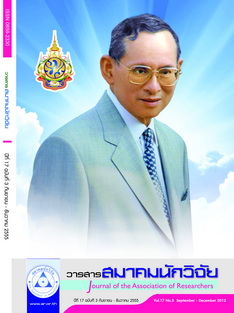THE MILK YIELD VALUE INCREASING OF PRIMIPAROUS COWS BY THE SEPARATING TECHNIQUE
Main Article Content
Abstract
The purpose of this experimental research was to study and to compare milk yield products, eating behaviors as a whole, crucial factors effecting on the milk yield products, linear regression equation for predicting milk products, and business incomes from milk yield products, of both Primiparous Cows groups of Separating Technique (24 cows of experimental group) and Grouping Technique (24 cows of the control group). Also, this study was conducted in 8 weeks. Data from the experimental method were analyzed by means, standard deviation, one-sample t-test, independent sample t-test, and computing by hand with linear regression equation, and integral for computing the quantity of milk yield products within 307 days. Moreover, the Stepwise-multiple regression correlation was applied to the questionnaire. Research results were as follows: 1) In the first week, there was no significant difference at the .05 level between both groups of primiparous cows with separating technique and with grouping technique on the milk yield products. 2) In the second to the eighth weeks, a group of primiparous cows with separating technique gave higher milk yield products than a group of grouping technique at the .05 level of significance. 3) In an experimental duration of eight weeks, each primiparous cow with separating technique gave the milk yield product at an average 17.23 kilogram a day. On the contrary, each cow of grouping technique gave at average 14.66 kilograms a day. It was also found that cows with separating technique gave higher milk yield products than a cow with a grouping technique at 17.53 percent when compared with the established criteria above 10 percent at the .05 level of significance. 4) In an experimental duration of eight weeks, a group of primiparous cows with separating technique had higher behaviors of eating as a whole than a group of cows with a grouping technique at the .05 level of significance. 5) As a result of significant testing at 95 percent of confidence, it was found that milk yield products of primiparous cows with separating techniques could be increased if the temperature at that area was decreasingly, and farm owners paid high attention with that separating technique. 6) The linear regression equation from the experiment for computing the quantity of milk yield product of primiparous cows with separating technique, in case of a year of 307 days and no other factors identifying, was as follow: y = -0.02X + 17.23, [when y = total quantity of milk yield product and X = number of milk yield days). 7) In the case of a milk yield year of 307 days, each primiparous cow with separating technique and with grouping technique gave the average of the income at 73,609 and 61,095 baht, respectively. It was also found that each cow with separating technique gave higher incomes average than each cow of grouping technique at 20.50 percent.
Article Details
บทความที่ปรากฏในวารสารนี้ เป็นความรับผิดชอบของผู้เขียน ซึ่งสมาคมนักวิจัยไม่จำเป็นต้องเห็นด้วยเสมอไป การนำเสนอผลงานวิจัยและบทความในวารสารนี้ไปเผยแพร่สามารถกระทำได้ โดยระบุแหล่งอ้างอิงจาก "วารสารสมาคมนักวิจัย"
References
Albright, J. L. (1978). Social consideration in grouping cows in large dairy herd management. In C.J.
Wilcox & H.H. Van Horn, (edn.). pp. 757-779. Gainesville, Florida: University Press of Florida.
__(1993). “Feeding behavior of dairy cattle.” Journal of Dairy Science. 76, 485-498.
Bolton, K. (2010). Economic of lactating dairy cow grouping strategies. Wisconsin: University of Wisconsin- Extension, Cooperative Extension Center for Dairy Profitability.
Coppock, C. E. (1977). "Feeding methods and grouping systems.” Journal Dairy Science, 60, 1327 -1336.
Dado, R. (1994). “Nutrition,” Journal of Dairy Science. 77, 132 - 144. De Vries, T. J, & Von
Keyserlingk, M. A. G. (2006). “Feed stalls affect the social and feeding behavior of lactating dairy cows.” Journal of Dairy Science, 89(9), 3522-31.
Earleywine, T. J. (2001). Profitable dietary grain concentrations and grouping strategies in dairy herds. Ph.D. Dissertation, University of Wisconsin - Madison. Food and Agriculture Organization. (2011). FAOSTAT. “Food outlook 2011.” Retrieved August 20, 2011,
from http://www. fao.org/ Gabriella A. Varga. (2003). “Do we need two closed up dry cow groups?” Advances in Dairy Technology, 15, 331.
Grant, R. J., & Albright, J. L. (1997). Dry matter intake as effecting by cow-grouping and behavior. In Proceedings of the 58th Minnesota Nutrition Conference, pp. 93-103, Bloomington, Min nesota: University of Minnesota.
Grant, R. J., & Albright, J. L. (2000). “Feeding behavior.” Farm Animal Metabolism and Nutrition: J.P.F.D = Mello, ed., Wallingford, Oxon, UK: CABI.
Grant, R. J., & Albright, J. L. (2001). Effect of animal grouping on feeding behavior and intake of dairy cattle. Journal Dairy Science 84, E156-E163.
Hasegawa, N., Nishiwaki, A., & Sugawara, K. (1997). “The effect of social exchange between two groups of lactating primiparous heifers on milk production, dominance order, behavior, and adrenocortical response.” Applied Animal Behavior Science.” 51, 15 – 27.
Nordlund, K., Cook, N. & Oetgel, G. (2006) Commingling dairy cows: Pen moves, stocking density, and health. Madison, Wisconsin: Department of Medical Sciences, School of Veterinary Medicine, University of Wisconsin.
McGilliard, M.L., Swisher, J.M., & James, R.E. (1983). “Grouping lactating cows by nutritional Requirements". Journal Dairy Science, 66, 1084-1093.
Cook, N. B., Nordlund, K. N. & Oetgel, G. R. (2004). Solving fresh cow problem: The importance of cow behavior, Page 248-253 In proceedings of 8th Dairy Symposium of the Ontario large herd Operators, March 9-11, London, Ontario
Olofsson, J. (1999). “Competition for total mixed diets fed for, adlibitum intake.” Journal Dairy Science, 82, 69 - 79.
Ostergaard S., Thomson P. T., (2010). “Separate housing for one month after calving improves production and health in primiparous cows but not in multiparous cows.” Journal Dairy Science, 93(8), 3535-3541.
Phillips C. S., Rind M. I. (2001). “The effects on production and behavior of mixing uniparous and multiparous cows.” Journal Dairy Science, 84, 2424-2429.


